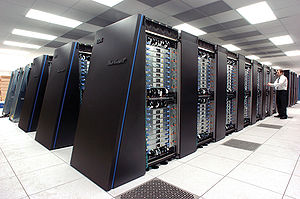A Computer the Size of the Universe
A collaboration of scientists from around the world have reached an unfathomable goal, one that could drastically change the way that we look at computers forever. North American, Australian, and South African scientists have built a crystal about 1 mm in diameter and consisting of only 300 atoms, that will be able to power a computer to do calculations beyond our wildest dreams.
Unless you’re a physicist, it’s tough to really understand the significance of what was discovered. Dr. Michael Biercuk from Sydney University was able to eloquently explain it for the average Joe to understand. Biercuk described the world of quantum computing to Australian news correspondent Connor Duffy: “Quantum computing is a kind of information science that is based on the notion that if one performs computations in a fundamentally different way than the way your classical desktop computer works, there’s a huge potential to solve a variety of problems that are very, very hard or near impossible for standard computers.”
This international team did think about computations in a different way, and are on the right track to solving some of the most seemingly impossible issues facing scientists today. It’s first important to understand how information is stored in a traditional computer before we can understand how so much data can be analyzed using this new discovery. Most of us have seen the back-end of a computer where it’s all just 1′s and 0′s. A bit is the basic unit of information in computing, expressed as those 1′s or 0′s. A bit is the smallest increment of data on a computer. Eight bits make up a byte. 1,024 bytes make up a kilobyte (KB). 1,024 kilobytes make up a megabyte (MB) and 1,024 megabytes make up a gigabyte (GB). So your 32 GB IPod can store 275 billion bits of information!
In quantum computing, information is measured in quantum bits or qubits. A qubit is not limited to only being a 1 or a 0, a qubit can also be what is called a superposition of the two. This means the qubit can be both 1 and 0 at the same time, and all of the points in between. This is a stark contrast from the bit, which is black and white, either 1 or 0 and that’s it. This difference allows for millions of possibilities within one qubit; increasing computational efficiency and capability.
It was widely accepted that a supercomputer using quantum information wouldn’t be possible for another 50 years. When scientists from these three continents got together, though, they achieved the incomprehensible. These scientists created a crystal “from scratch, atom by atom” that contains more programmable qubits than we thought we could ever cram together. When linked up to microwave and laser pulses, a system of electrical and magnetic forces causes the qubits to interact, and to potentially solve problems anywhere from 10^10 to 10^80 times more complex and faster than the top supercomputer that we have today.
Dr. Biercuk says “If you wanted to think how big a classical computer would need to be in order to solve this problem of roughly 300 interacting quantum particles it turns out that that computer would need to be the size of the known universe, which is clearly something that’s not possible to achieve.”
The crystal itself is the computer, the brain, the central element. It’s only one atom thick and a millimeter wide! It still needs to be connected to a system of vacuum chambers, pumps, and lasers to power it. This entire system would still take up the size of a large room, but the computational capabilities are undeniable.
Some of the potential applications of this computer lie in the complex fields of quantum mechanics and quantum magnetism; it’s speculated that we may now be able to “analyze photosynthesis at an atomic level and develop materials for power distribution that allow electricity to flow without resistance.” The calculations that can now be performed are so complex, we can’t even check their accuracy because no other computer even compares! Basically, it can do things that would make your brain explode.
Biercuk speculates that it could take a decade or two before this technology becomes commercially available; but that’s something that sounded ludicrous just a couple of years ago. It’s tough to really grasp the magnitude of the discovery, but the main takeaway is that this is a tremendous leap in technology, one that will further our capabilities to do things never ever imagined to be possible.
Comments
Tags: computer of the future, crystal computer, micro crystal, quantum computing, qubits, super computer, supercomputer
Trackback from your site.



Comments (1)
Observer
| #
I like the idea that we can’t check the accuracy, it could come in handy on a homework assignment, “Looks good to me”. I am truly awed by the abilities of the human to imagine and implement ideas of this magnitude. Truly “astounde-ing”
Reply